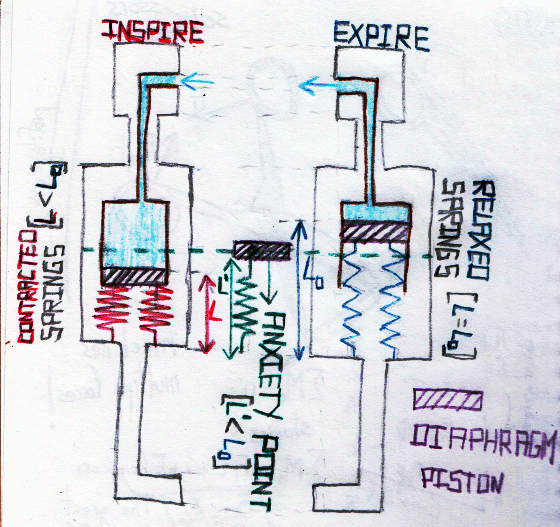All my life I have been picturing breathing the wrong way. Inhaling was up, exhaling down. Probably following my shoulders or chest motion. Even (theoretically) knowing that lungs need a negative pressure from the diaphragm to draw air, my brain insisted interpreting this process as going up. Moreover, when trying to relax I have always focused on breathing in and dismissed the opposite process, breathing out. The evacuation of air seemed quite a secondary thing. The magic was brought by the clean and fresh air coming to my body, while the rest was just an irrelevant excretion of non-wanted CO₂. Well, this was a completely mistaken point of view. After all, singing is, for the most part, exhaling with grace!
For at least four years now I have been struggling with some kind of anxiety (who doesn't today?). My way of perceiving it is twofold: on the one hand I notice some kind of heat near the belly, and on the other I feel like not being able to fully exhale. It's not shallow breathing: I can easily take a decent volume of air, but it's like there is a point beyond which I can't exhale any more of it. There is a residual volume that can't go out. I recall being able to fully exhale and feeling very relaxed in the past. Now there is a wall, meaning the diaphragm cannot completely relax.

When learning meditation, almost everyone recommends focusing on breathing, but you rarely hear about the details of it. Even when receiving singing lessons, teachers used a language that was foreign to me. I needed more anatomy knowledge. For example, I find very important to know that the diaphragm has a hole (in fact more than one) where the end of the oesophagus meets the stomach, and that by becoming weak, part of the stomach can pass through this hole, called hiatus, and become strangled by it, producing a hiatus hernia.
As already said, focusing on breathing has allowed me to notice that my diaphragm is able to relax only up to a point. At least this is what I feel, although there could be other reasons, like some blocked rib joints not allowing this final bit of exhalation. In either case, it is interesting to see how the internal intercostal and abdominal muscles can force the process. When practising this, I can reach a complete release of the air by forcing these auxiliary muscles to complete the process that my compressed diaphragm cannot finish. This helps a lot when trying to relax, and subsequent non-forced exhalations seem to be better, as if by forcing the diaphragm to a different state relieves tension from it. The forcing process can either be gentle (isometric) or violent (exhaling with one or two strokes). I find the latter to have specially strong effect afterwards.
Instead of so much advice about counting breaths or asking to take deep inhalations, I would find much more useful to explain how the mechanism of the muscles are involved, in order to allow the mind to depict a visual model that corresponds to the actual motion of this anatomy. I think that having my up-down concept at odds with the actual motion of the diaphragm has contributed to a disfunction of it, almost like a shortcut. Also, focusing on how the diaphragm relaxes and how the internal intercostal and abdominal muscles can assist the process seems to me a much easier and meaningful way to focus on breathing.
Perhaps counting or just breathing relaxedly is the next level once these problems are solved, but I don't understand how the advice of 'relaxed breathing' could help someone who is not relaxed mainly because she can't properly breath in the first place. 'Relax' is the worst advice towards relaxation, and 'breath calmly' does not sound better to me ('count' is even worse). Instead of such arithmetic I would prefer to be taught about the biomechanics, the fluid dynamics and the physiology of breathing first. Only then I can begin to count and perhaps, some day, to relax.
I'll keep working to achieve a non-forced and complete exhalation. But instead of trying magical relaxation and feeling bad when magic is not working (fun fact: it never works), now I can assist the process, seek strategies for diaphragm stretching and looking for some possible lack of rib mobility. Trying to avoid stressful experiences also sounds a bit magical, not to mention the hand waving of not letting them affecting me. For now, there is a practical and non-mystical approach I can follow to fight stress.
When air vibrates, we have very different mechanisms for receiving and emitting sounds. Perhaps we could separately study the two sides of respiration as well. Two air-related mechanisms. Two vibrating diaphragms. Both asymmetric, but with one asymmetry not balancing the other. Let's learn how to deeply listen and how to deeply exhale. Let the words in and let the air out. Perhaps these two systems are more related than it seems. What if we take air in to speak out, and also to breath out to get rid of all the information that gets in?